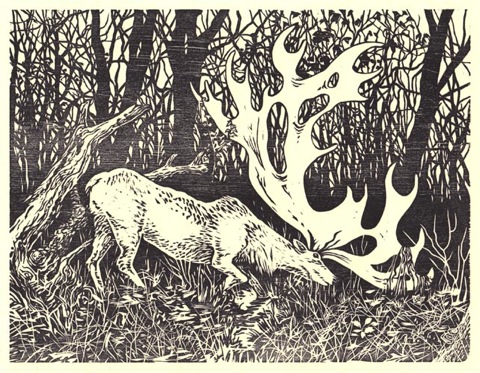After Darwin: An Organ Injurious
23/11/10 16:36 Filed in: Pellinore Press | After Darwin
I thought I’d use this blog post to go into a bit of my thinking for the first print in our After Darwin print subscription series. The title of the piece is An Organ Injurious.
Part of what attracts me to On the Origin of Species is that, despite Darwin’s cohesive, developed idea of natural selection, scientific fields which would supply some of the missing pieces, such as genetics, were nascent at best. As such, there is a sense of the explorer as author about the work, complete with wonder, epiphanies, and stumbles. Darwin struggled to find a catalyst for the variation of traits that would be inherited based on the mechanism of natural selection. In the chapter on Laws of Variation, Darwin cites use and disuse as probable catalysts. He says, speaking of beetles inhabiting the island of Madeira:
For during thousands of successive generations each individual beetle which flew least, either from its wings being ever so little less perfectly developed or from indolent habit, will have had the best chance of surviving from not being blown out to sea; and, on the other hand, those beetles which most readily took to flight will oftenest have been blown to sea and thus have been destroyed.
Darwin later states:
Again, an organ useful under certain conditions, might become injurious under others, as with the wings of beetles living on small and exposed islands; and in this case natural selection would slowly continue to reduce the organ, until it was rendered harmless and rudimentary.
This led me to think of the antlers of deer, employed by males of many species as an attraction to females. At what point is the size of the antlers inimical rather than beneficial? It was once believed that the Irish Elk (more accurately Giant Deer) became extinct due to the large size of its antlers.
Here is a proof of the first of two blocks which will compose this print. This is not the final color.
 Read More...
Read More...
Part of what attracts me to On the Origin of Species is that, despite Darwin’s cohesive, developed idea of natural selection, scientific fields which would supply some of the missing pieces, such as genetics, were nascent at best. As such, there is a sense of the explorer as author about the work, complete with wonder, epiphanies, and stumbles. Darwin struggled to find a catalyst for the variation of traits that would be inherited based on the mechanism of natural selection. In the chapter on Laws of Variation, Darwin cites use and disuse as probable catalysts. He says, speaking of beetles inhabiting the island of Madeira:
For during thousands of successive generations each individual beetle which flew least, either from its wings being ever so little less perfectly developed or from indolent habit, will have had the best chance of surviving from not being blown out to sea; and, on the other hand, those beetles which most readily took to flight will oftenest have been blown to sea and thus have been destroyed.
Darwin later states:
Again, an organ useful under certain conditions, might become injurious under others, as with the wings of beetles living on small and exposed islands; and in this case natural selection would slowly continue to reduce the organ, until it was rendered harmless and rudimentary.
This led me to think of the antlers of deer, employed by males of many species as an attraction to females. At what point is the size of the antlers inimical rather than beneficial? It was once believed that the Irish Elk (more accurately Giant Deer) became extinct due to the large size of its antlers.
Here is a proof of the first of two blocks which will compose this print. This is not the final color.
 Read More...
Read More...0 Comments